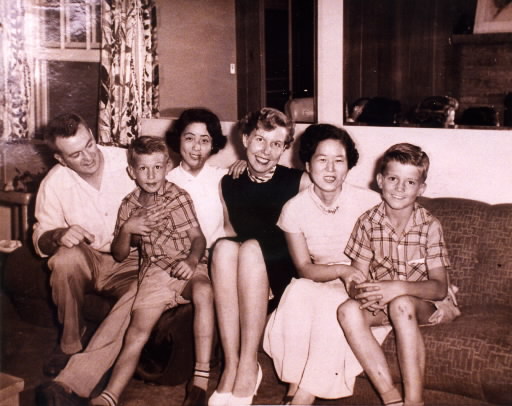Hiroshima Girls, Part 1: Life in Canada [3]
Jul. 3, 2010
Smile returns as surgery in the U.S. heals body and mind
by Masami Nishimoto, Staff Writer
This feature series on the "Hiroshima Girls," also known as "Hiroshima Maidens," is a close look at a number of Japanese women who were impacted by the atomic bombing of Hiroshima. The series was originally published in 1996.
The photo shows the women, their faces stiff, waving goodbye to their families as they leave Japan aboard a U.S. Air Force C54 plane. Gazing at the photo, Misako Tachibana, 66, described the women's feelings on their departure, filled with both hope and apprehension. "We clung to the possibility, however small it was, that we might look a little better."
On May 5, 1955, 25 young unmarried women, ranging in age from 18 to 31, took off from the U.S. Iwakuni Airbase escorted by American and Japanese doctors and others. They were bound for New York, 12,000 kilometers away. With hops along the way at islands in the Pacific Ocean, the journey took five days.
The project to perform reconstructive plastic surgery on the "Hiroshima Girls," which then led to the enactment of the Atomic Bomb Medical Relief Law in 1957, was initiated by Reverend Kiyoshi Tanimoto (who died in 1986) of the Hiroshima Nagarekawa Methodist Church, and the journalist Norman Cousins (who died in 1990), involved in the "moral adoption" of A-bomb orphans and later made an "Honorary Citizen of Hiroshima."
The surgery was to be performed in the former "enemy country" which had dropped the atomic bombs. The project thus provoked a derisive response from a segment of the A-bomb survivors. Nevertheless, the treatment for the young Japanese women, carried out over a period of a year and a half, was marked by consistent cooperation and the volunteer services of American and Japanese civilians.
Plastic surgery on the keloids was undertaken at Mount Sinai Hospital, founded by Jewish-Americans in 1852. Quaker families, pacifist in belief, offered accommodations for the women, one pair per family, between the periods of hospitalization.
"They were humble, but shining examples of great human beings. They treated us just like their real daughters," recalled Ms. Tachibana as memories flowed back to her while turning pages of the photo albums she had carefully stored on the bookshelf. Her voice grew more animated as she recounted episodes that took place at the more than ten families the women stayed with.
Ms. Tachibana could not address her host parents without adding the honorary suffix typical in Japanese, so she continually called them "Papa-san" and "Mama-san." She recalled the warm compliment of "Smart!" that the father, a keen fisherman, made when she cut sashimi from the filet of sea bream and produced soup from the fish heads. She remembered, as well, how the young brothers of her host family stayed tightly by her side when she came home from the hospital after an operation which left her hand temporarily affixed to her cheek for a skin graft.
Despite the language barrier, such small occurrences and emotional exchanges moved her and struck within her a responsive chord. Before going to the United States, she abhorred being photographed, but before she knew it, so many photos had been taken of her that they formed a photo album adorned with smiles.
Japanese-Americans who had been forced to live in the internment camps during World War II visited the hospital with Japanese food. The young women were also hugely grateful for the devoted care provided by Hatsuko Yokoyama, 87, of Nishi Ward, Hiroshima, who escorted them from Japan on behalf of their worried parents. Ms. Tachibana remarked, "I came to persuade myself to live fully without withdrawing from life."
One year after their arrival in America, one of the women, aged 25, died in an accident involving anesthesia. Ms. Tachibana was scheduled to undergo the next surgery. She keenly felt the shock and anxiety of everyone concerned, as well as their consideration toward her, but did not hesitate to take her turn on the operating table. "Thank you," a tearful Norman Cousins told her, grasping her hands.
Ms. Tachibana received a total of nine surgeries on her left hand and cheek, disfigured by the atomic bombing. However, her ring finger and little finger did not recover because they had been burned to the bone.
"I was able to regain the joy of life and the courage to live because I was touched by the genuine love of so many people," Ms. Tachibana said. "That meant more to me than the surgery itself."
Once back in Japan, she embarked on realizing her aspirations for the future.
(Originally published on June 19, 1996)








